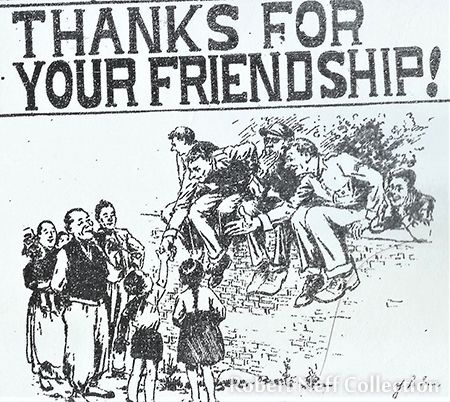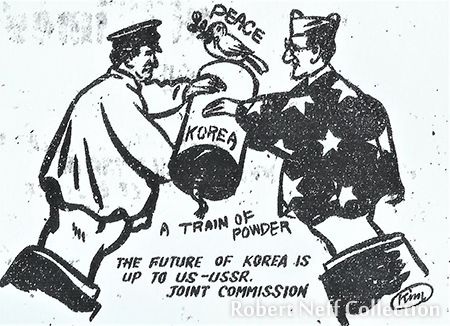|
|
|
Origins of the Cold War[There is a whole unit on the Origins of the Cold War, if you wish to go into any aspect in more detail.] During the Second World War against Nazi Germany, the USA and USSR were allies, but they were not friends. The two sides had massive ideological differences: • The USA was capitalist (believing in market enterprise and individual profit); the USSR was communist (believing in state control of the economy and individual service). • The USA believed in freedom of political expression; the USSR required political expression only within strict communist limits. They had equally massive differences in their strategic ambitions: • The USA wanted to rebuild a world of democracies and capitalist trading partners, including Germany; the USSR wanted to help communist revolutions worldwide, assemble a protective buffer of satellite states in eastern Europe, and destroy Germany. The result was that – even as they met at a series of wartime conferences to agree the outcomes of the War – the USA and USSR were manoeuvring for position. One of the disasters of the British advance into Europe – the defeat and capture of British paratroopers at Arnhem – came about because Churchill was trying to advance too quickly, in order to get to Berlin before the Russians. And one of the factors in the American decision to drop the atomic bomb on Hiroshima was to bring the War in the Pacific to a quick end … because – with Germany defeated in Europe – Stalin had started to advance against the Japanese into East Asia. After the War, therefore, the peace quickly descended into a ‘Cold War’. • In eastern Europe, Stalin-backed communists seized control of the ‘Iron Curtain’ countries, and there was a crisis stand-off when Stalin blockaded West Berlin in 1948-49. • In East Asia, there were communist revolutions and demonstrations, culminating in the communist take-over of China in 1949.
|
|
Two StandpointsThe USA saw Stalin as the aggressor and the danger: • In March 1947, President Truman declared a policy of ‘containment’ to stop any further growth of Soviet power (the so-called ‘Truman Doctrine’). Congress voted $17 billion of aid (the ‘Marshall Pan’) to help strengthen the economies and militaries of democratic countries in western Europe. • US Secretary of State Dean Acheson described Communism as a rotten apple in a barrel which, if not stopped, would spread to the rest of the world. • For some people in America, ‘containment’ was not enough. In April 1950, the American National Security Council issued a report (NSC 68) recommending that America abandon 'containment' and start 'rolling back' Communism. • A communist scare gradually grew in the USA, especially after 1948, when the so-called ‘Pumpkin Papers’ revealed that Alger Hiss, a senior US government official who had helped set up the United Nations, was in fact a Soviet spy. Congress’s House Un-American Activities Committee (HUAC) sought out communists in high-profile roles, starting with the ‘Hollywood Ten’ filmmakers in 1947. Government departments started to carry out loyalty reviews, and Truman sacked 425 government employees suspected of homosexuality (because they were considered a blackmail risk).
The USSR saw America as the aggressor and the danger: • Stalin regarded Churchill’s 1946 speech denouncing the ‘Iron Curtain’ as a declaration of war. • He regarded Marshall Aid as economic ‘war plans’ using blackmail to shackle western countries to the USA and its interests. • He accused the USA of empire-building. • The USSR, however, was limited in its options because the USSR did not develop the atomic bomb until 1949 and, even then, remained well-behind the USA in the nuclear arms race until the 1960s.
|
Source ACommunism was acting in Korea just as Hitler, Mussolini, and the Japanese had acted ten, fifteen, and twenty years earlier. If this was allowed to go unchallenged, it would mean a third world war, just as similar incidents had brought on the second world war. President Truman, writing in his memoirs (1955).
|
B - The USA and the USSR in KoreaAt Cairo in 1943, ameeting to discuss theur war aims, the Alies declared that "in due course Korea shall become free and independent". On 10 August 1945, as Soviet forces marched into Korea, the USA and the USSR agreed that, pending the creation of a united independent state, Korea would be divided at the 38th parallel into a northern zone (under Soviet occupation) and a southern zone (under American occupation). In December they agreed that this period of 'trusteeship' would last five years. A US-USSR Joint Commission met in 1946-47 to try to negotiate a plan for unification, but failed.
The USSRThe Soviet Army entered northern Korea on 10 August 1945. • They found that ‘People’s Committees’ had sprung up throughout the country and were already running local government. These became the basis of the new government. • The Russians had brought with them 67 Korean Soviet Army officers who had fought in the guerrilla war against the Japanese, and had lived and trained in the USSR since 1941. One of them, Kim Il Sung, was named as the leader of a new North Korean government, the DPRK. • It is unclear how much influence the Soviet Union exerted over the DPRK, but the historian Bruce Cumings estimated that its power did not extend much beyond the capital, Pyongyang. • Stalin did let Kim Il Sung have the Soviet weaponry – including the MiG planes, tanks and artillery – left over in Korea and Manchuria after the War, and Soviet military advisers trained the ‘Korean People’s Army’ (KPA) in guerrilla and conventional warfare. • However, when Kim suggested attacking South Korea in 1949, he was told that the USSR would not support him if he did.
|
Source B
This cartoon from the Seoul Times of 24 March 1946 shows two figures (perhaps Soviet Commissar for Foreign Affairs Vyacheslav Molotov and US Secretary of State James F. Byrnes) trying to defuse a bomb.
Source C
This cartoon from the Seoul Times of 14 September 1945, shows some American soldiers sat on a wall, being visited by a group of Koreans.
Source DKMAG is a living demonstration of how an intelligent and intensive investment of 500 combat-hardened American men and officers can train 100,000 guys to do the shooting for you... The American taxpayer has an army that is a fine watchdog over the investments placed in this country and a force that represents the maximum results at minimum cost. General WIlliam Roberts, interviewed by New YorkTribune reporter Marguaritte Higgins (May 1950).
Did You KnowWhen they approached a young Korean woman, American soldiers often misunderstood the rebuff: "Oh no! I am seikse!" (= "I am a virgin").
|
The USAUS forces arrived in South Korea on 8 September 1945. • Informed by the Japanese that Communists were seeking to take control of Korea, the Americans dropped leaflets telling Koreans to obey the Japanese authorities until US forces arrived; even after arrival, they allowed the Japanese to guard Japanese property, wearing US Army armbands (you can guess how popular that was). • On arrival, the Americans found that ‘People’s Committees’ had sprung up throughout the country and were not only running local government but had set up a government – the ‘People's Republic of Korea’ – in the capital city, Seoul. This they outlawed and, instead, formed a military government, using the organisations set up under the Japanese Empire (you can guess how popular that was). • The US military government was a disaster. Since all the Japanese (who had run everything) had been repatriated, uttery unqualified soldiers found themselves running government departments. Since they did not speak the language or understand the politics, they befriended those Koreans who could speak English, who were usually rich, Christian and right-wing. The American soldiers shot, assaulted and racially abused Koreans; looted, got drunk and opportuned young women. In 1946, a poll found that almost half of South Koreans preferred their old Japanese overlords to their new American liberators. • Then the Americans flew in from the US Syngman Rhee, a Christian Korean nationalist, who since 1925 had been living in the United States, as President of the new country. • Most South Koreans hated the American occupation. When the US took over control of Seoul Zoo, zoo workers refused to take care of the animals, which died of neglect. More seriously, in 1946 there was a popular uprising in Daegu when a strike was fired on by police, the result of Korean anger with the American occupation and the suppression of the people’s committees. The US Army put down the rebellion, leaving 611 people dead, and 2,609 arrested. • When it departed in 1949, the US Army left the ROK $110 million-worth of military equipment. What the ROK army did not have were tanks and fighter planes. This was because the Americans were worried that, if Rhee had enough equipment, he would launch an attack on North Korea and start a World War.
|
|
Consider:1. Study Section A and make a list of all the ways the Cold War made a war in Korea more likely. Did it make a war in Korea inevitable? 2. Interpret the messages in Sources B and C, looking both at the content and the provenance of the cartoons. 3. Source D is VERY revealing about the way the USA saw its involvement in South Korea. What can you infer from the Source about how General Roberts regarded the ROK? 4. 'The USA did everything wrong in Korea.' Make a list. Do you agree? 5. 'The USSR got it spot on right in Korea.' Make a list. Do you agree?
|
|
|
|
|
|
Spotted an error on this page? Broken link? Anything missing? Let me know. |
|

